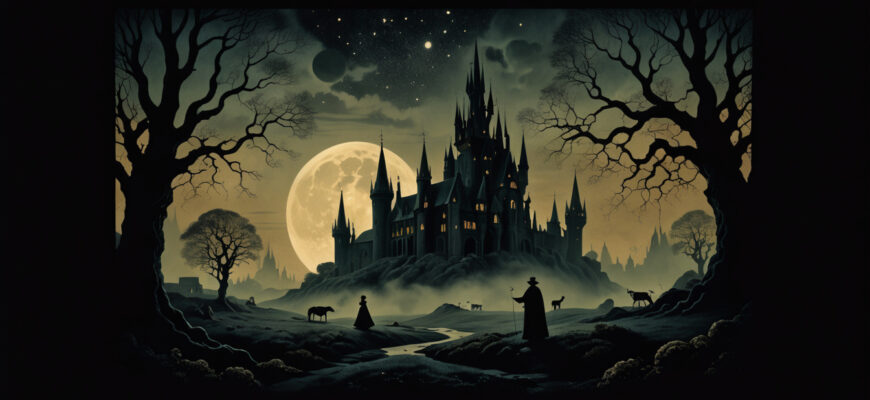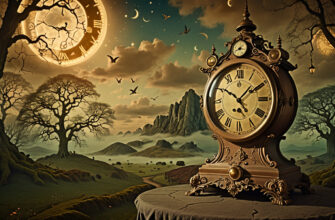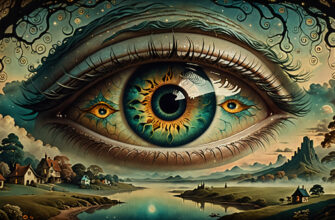Ever woken from a dream where black wasn’t just a color but a whole feeling? Black in dreams stirs up a landscape much richer than simply “darkness.” It hints at the quiet, sometimes heavy spaces where grief settles, transformations begin, and the soul works through shadows that everyday light won’t touch. Black’s role in a dream can puzzle or unsettle because it’s not just about the absence of color—it’s about what simmers beneath the surface, unseen but deeply felt. It might show up as endless night skies, mysterious animals cloaked in shadow, or garments that both hide and protect. These images invite reflection on loss, change, and spiritual passage.
- Understanding Black In Dreams: More Than Darkness
- How Dreams Use Black To Signal Inner Boundaries And Shadows
- A Queer, Feminist Lens On Black Dreams
- Black Dreams as Calls to Reckoning and Rebirth
- Recognizing Hidden Truths in Black Dream Symbols
- Mourning Old Versions of Self: Death, Decay, and Fertile Ground
- Black as a Spiritual Chrysalis: Old Endings, New Beginnings
- Interpreting Black Shadows as Invitations to Personal Transformation
- Navigating the Emotions: Grief, Loss, and Healing through Black Dreams
- Processing Grief in Dreamspace: Dreams as Emotional Outlets
- Black and the Lingering Presence of Loss or Trauma
- Using Black Dreams to Cultivate Compassion for Yourself
- How Holding Space for Mourning in Dreams Supports Healing
- Myth, Archetypes, and Cultural Contexts Around Black in Dreams
- Black Animals and Their Symbolism in Dream Traditions
- Black Garments and Cultural Associations with Mystery and Power
- Mythological Figures and Black as Threshold Guardians
- How Intersectionality Enriches Understanding of Black Dream Symbols
Understanding Black In Dreams: More Than Darkness
Black consistently emerges as the color of mourning in cultures worldwide, holding space for grief that’s too big or raw to express openly. When black floods a dream, it can be echoing that silent sadness—whether from recent loss or old wounds still quietly shaping experience. Beyond sorrow, black also signals a fertile ground where transformation takes root. Think of it like soil: dark, rich, and full of the potential for new growth after decay. Dreams featuring black often carry this paradoxical nature—endings intertwined with fresh beginnings, the dark night before dawn.
This shift between death and renewal in the subconscious is where black’s spiritual resonance deepens. It’s the shadow-play of the psyche, layers folded on layers, inviting you into the mystery of what’s hidden and waiting to emerge. Black in dream imagery might appear as the sweeping sky of night, the sleek fur of an animal like a raven or panther, or the flowing fabric of a cloak or dress—each symbol loaded with personal and cultural meanings. For instance, a black garment can represent protection or concealment, an animal may embody power or the enigmatic parts of the self, and the vast black sky can express the infinite unknown or cosmic void.
Peeling back black’s shadowy layers often reveals a spiritual dimension—a reminder that darkness is not just absence, but a rich, necessary space for inner work. It can signal a journey through the unconscious where grief, power, and rebirth mingle. This makes black a potent symbol in dreams, more than just a shade; it’s a sacred invitation to explore what’s both deeply personal and universally human.
How Dreams Use Black To Signal Inner Boundaries And Shadows
Black often marks borders inside the psyche, where the familiar meets the unknown self. These inner boundaries show where parts of the personality might be guarded or repressed. When black enters a dream, it can be an alert pointing toward aspects of the shadow self—the emotional patterns, fears, or desires we usually keep out of sight.
Imagine dreaming of a black animal—a crow, a snake, or even a black cat. These figures don’t just represent animals but personal metaphors. Maybe the black cat signals independence laced with mystery, or the raven represents transformation and a message from the unconscious. The black night sky enveloping a dream can feel vast or claustrophobic, depending on where you stand in your life. These images often hold a mirror to your internal landscape, reflecting what’s ready to be noticed or integrated.
Not all black dreams feel comfortable—sometimes the presence of black triggers discomfort, fear, or resistance. This unease is a signal, an indication that something challenging is unfolding within. Instead of pushing away these feelings, embracing the discomfort can spur growth and healing. It’s like touching the edges of your own night: unsettling but necessary for breaking through old fears or limitations.
- Black as a boundary helps identify where protections are needed—and where those walls might be softened to allow more vulnerability.
- Seeing black in dreams can highlight unresolved grief or shadow material that needs gentle attention.
- Discomfort in black dreams often signals an opening, a threshold for transformation.
Each dream acts as a kind of cosmic weather report, showing where emotional storms brew and where clearing might happen next.
A Queer, Feminist Lens On Black Dreams
Viewing black through a queer and feminist lens opens up new ways to understand the complexity it carries in dreams. Black isn’t just a passive backdrop—it holds power in its vulnerability and the possibility for rebirth. For those navigating identities outside the norm, black can symbolize the tension between hiding and showing up, protection and exposure, and the courage to embrace both states.
Black in this light resists simple interpretations. It becomes a tool in dreamwork that holds space for discomfort, non-linearity, and emergence. For example, dreaming of black garments might connect to how one dresses or shields identity in waking life, or black shadow figures could represent aspects of self traditionally silenced or marginalized. A feminist reading doesn’t shy away from that shadow but invites holding it with compassion and curiosity.
This approach fosters a relationship with dreams where discomfort is respected as part of growth rather than something to be avoided. By leaning into these shadows, it becomes possible to reclaim power and build identity from places that once felt fragmented or erased. Black dreams can activate deep reckonings and open pathways toward becoming fully embodied in all the complexity and resilience that identity holds.
The transformative energy of black in dreams is an affirmation: You were born for this. Whether it challenges, unsettles, or comforts, black invites you to hold space for yourself in all your layers—navigating shadow and light with both courage and tenderness.
Black Dreams as Calls to Reckoning and Rebirth
Have you ever woken up from a dream drenched in black—complete darkness, black animals, or endless night—and felt something simmering beneath? Black in dreams carries a weight that’s both heavy and fertile, asking us to confront truths that hide in shadows. These dreams aren’t just about fear or loss; they often beckon us to reckon with old versions of ourselves and prepare for healing and rebirth.
Recognizing Hidden Truths in Black Dream Symbols
Black often signals parts of our psyche tucked away in the unconscious, truths we’ve tucked into dark corners. For example, dreaming of a black cat might stir up feelings around intuition, mystery, or even superstition, nudging us toward what’s been unseen. These symbols whisper hidden stories—sometimes grief, sometimes power—that need witnessing. Recognizing these signs is less about fear and more about curiosity. What’s been masked or repressed?
Mourning Old Versions of Self: Death, Decay, and Fertile Ground
One of the hardest but most sacred parts of black dreams is their connection to endings. Black embodies death and decay, but it’s not meaningless ruin—it’s compost, the dark soil where new growth begins. Dreaming of black smoke or a black tree might represent mourning a past identity or phase. This space asks for grief, for honoring what must fall away so something new can sprout. Think of black as the sacred dark before dawn.
Black as a Spiritual Chrysalis: Old Endings, New Beginnings
Rather than stopping points, black dreams often function as chrysalis moments. Just like a butterfly’s cocoon, the black space enfolds transformation. It’s quiet, protective, and pregnant with possibility. You may dream of black garments or blackened landscapes as your soul’s signal to rest in the unknown. When you wake, you carry traces of that internal work—the death of old roles or stories—to step into a renewed self.
Interpreting Black Shadows as Invitations to Personal Transformation
Shadows in black dreams aren’t just to be feared. Instead, they can serve as gateways. Facing black shadows in dream settings encourages deeper self-scrutiny and invites courage. These shadows often represent the parts we try to avoid but are essential to wholeness. When interpreted as invitations, they become powerful calls to transform—pointing toward integration of loss, grief, and untapped strength. Embracing these shadows opens a path from darkness to light.
Navigating the Emotions: Grief, Loss, and Healing through Black Dreams
What do you do with the exhaustion or heaviness that black dreams can leave behind? Grief and loss swirl through black imagery like a tide, sometimes drowning, sometimes gently washing the shore of your soul. Interacting with these dreams can be a compassionate process, a way to move through emotions that don’t get space during waking hours.
Processing Grief in Dreamspace: Dreams as Emotional Outlets
Sometimes, dreams filled with black are where grief unloads. If you’ve recently lost someone or something important, the blackness offers an emotional outlet. Dreaming of infinite black skies or shadows can feel overwhelming but serves an emotional purpose: it’s a safe place to cry, feel emptiness, or just be with sadness without judgment.
Black and the Lingering Presence of Loss or Trauma
Black doesn’t always mean new beginnings right away. It can also embody trauma’s shadow, the residue of old wounds still alive beneath your skin. These dreams might replay feelings of suffocation or sinking, hinting that some grief is lingering. A dream with black clouds or dark water can mean the emotional terrain hasn’t yet been fully navigated. It’s okay to recognize this presence before moving forward.
Using Black Dreams to Cultivate Compassion for Yourself
Black dreams often beckon a softer internal gaze. When you see yourself in black or engulfed by darkness, it’s a reminder to hold kindness for your vulnerability. These dream moments encourage treating your internal shadow with tenderness—acknowledging pain without harshness. Cultivating compassion through these nocturnal narratives supports your emotional resilience.
How Holding Space for Mourning in Dreams Supports Healing
Grief is rarely linear, and black dreams show that perfectly. By holding space for this emotional ebb and flow within dreamtime, healing gets room to breathe. These dreams coax you to sit with discomfort and trust the process’s timing. When nights are filled with black, honoring that mourning process instead of pushing it away creates gentle alchemy from grief to growth.
Myth, Archetypes, and Cultural Contexts Around Black in Dreams
Every culture sees black through its own unique lens, coloring dream interpretations with rich layers of myth, spirituality, and archetype. Black in dreams taps into universal themes, but also the particular stories we inherit and live.
Black Animals and Their Symbolism in Dream Traditions
Across dream traditions, black animals carry potent symbolism. A black raven might evoke messages of wisdom or prophecy, while a black snake could signal transformation or hidden fears. These animals often serve as guides through the shadowed landscape of the dreamer’s psyche, embodying both mystery and power. Their appearances can be invitations to tune into primal instincts or ancestral wisdom.
Black Garments and Cultural Associations with Mystery and Power
Black clothing in dreams frequently intertwines with meanings of protection, authority, or concealment. Many cultures see black as the color of mourning, but also of dignity and strength. Imagine dreaming of someone cloaked in black—it might call attention to themes of anonymity, secrecy, or standing firm in personal power. Whether a black veil or suit, these garments stitch together stories of identity and social signals.
Mythological Figures and Black as Threshold Guardians
Mythologies feature black often, not as pure darkness, but as a marker of thresholds. Figures draped in black guard gates between worlds—guardian spirits, psychopomps, or tricksters. Their presence in dreams can mean you’re on the cusp of an initiation or breakthrough. The blackness they wear invites you into liminal spaces where transformation happens and new understanding unfolds.
How Intersectionality Enriches Understanding of Black Dream Symbols
Interpreting black in dreams gets deeper when you consider intersectional perspectives. Our experiences of race, gender, culture, and community shape how we relate to blackness itself—both waking and in dreams. For some, black might connect to cultural pride and resilience; for others, it can reflect external marginalization or internalized stigma. Paying attention to this nuanced context strengthens how a dream’s blackness speaks to personal and collective identities simultaneously.








